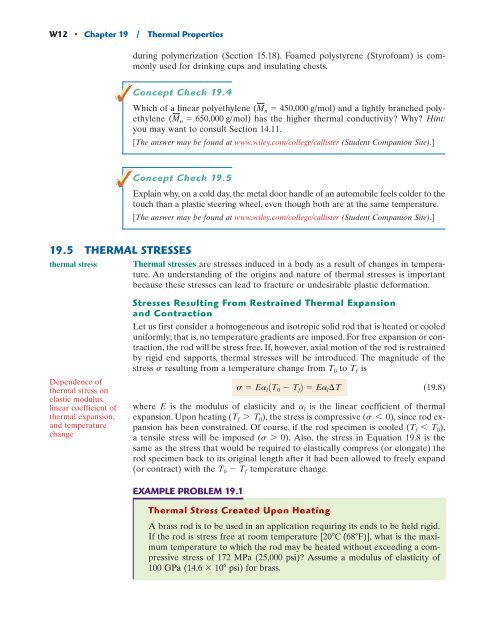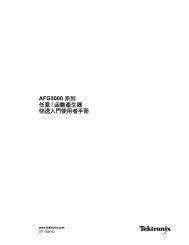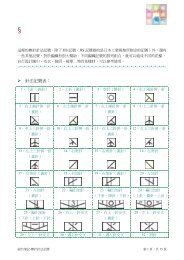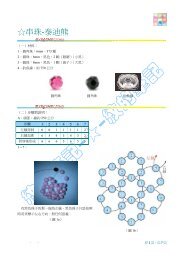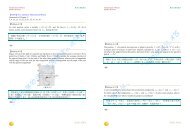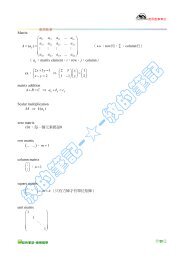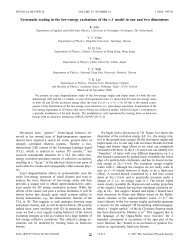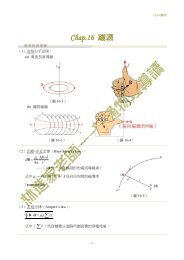Chapter 19 Thermal Properties
Chapter 19 Thermal Properties
Chapter 19 Thermal Properties
You also want an ePaper? Increase the reach of your titles
YUMPU automatically turns print PDFs into web optimized ePapers that Google loves.
W12 • <strong>Chapter</strong> <strong>19</strong> / <strong>Thermal</strong> <strong>Properties</strong><br />
during polymerization (Section 15.18). Foamed polystyrene (Styrofoam) is commonly<br />
used for drinking cups and insulating chests.<br />
Concept Check <strong>19</strong>.4<br />
Which of a linear polyethylene (Mn 450,000 g/mol) and a lightly branched polyethylene<br />
(Mn 650,000 g/mol) has the higher thermal conductivity? Why? Hint:<br />
you may want to consult Section 14.11.<br />
[The answer may be found at www.wiley.com/college/callister (Student Companion Site).]<br />
Concept Check <strong>19</strong>.5<br />
<strong>19</strong>.5 THERMAL STRESSES<br />
thermal stress<br />
Dependence of<br />
thermal stress on<br />
elastic modulus,<br />
linear coefficient of<br />
thermal expansion,<br />
and temperature<br />
change<br />
Explain why, on a cold day, the metal door handle of an automobile feels colder to the<br />
touch than a plastic steering wheel, even though both are at the same temperature.<br />
[The answer may be found at www.wiley.com/college/callister (Student Companion Site).]<br />
<strong>Thermal</strong> stresses are stresses induced in a body as a result of changes in temperature.<br />
An understanding of the origins and nature of thermal stresses is important<br />
because these stresses can lead to fracture or undesirable plastic deformation.<br />
Stresses Resulting From Restrained <strong>Thermal</strong> Expansion<br />
and Contraction<br />
Let us first consider a homogeneous and isotropic solid rod that is heated or cooled<br />
uniformly; that is, no temperature gradients are imposed. For free expansion or contraction,<br />
the rod will be stress free. If, however, axial motion of the rod is restrained<br />
by rigid end supports, thermal stresses will be introduced. The magnitude of the<br />
stress s resulting from a temperature change from to is<br />
(<strong>19</strong>.8)<br />
where E is the modulus of elasticity and is the linear coefficient of thermal<br />
expansion. Upon heating (Tf 7 T0), the stress is compressive (s 6 0), since rod expansion<br />
has been constrained. Of course, if the rod specimen is cooled (Tf 6 T0), a tensile stress will be imposed (s 7 0). Also, the stress in Equation <strong>19</strong>.8 is the<br />
same as the stress that would be required to elastically compress (or elongate) the<br />
rod specimen back to its original length after it had been allowed to freely expand<br />
(or contract) with the T0 Tf temperature change.<br />
EXAMPLE PROBLEM <strong>19</strong>.1<br />
s Ea l 1T 0 T f2 Ea l¢T<br />
<strong>Thermal</strong> Stress Created Upon Heating<br />
A brass rod is to be used in an application requiring its ends to be held rigid.<br />
If the rod is stress free at room temperature what is the maximum<br />
temperature to which the rod may be heated without exceeding a compressive<br />
stress of 172 MPa (25,000 psi)? Assume a modulus of elasticity of<br />
100 GPa ( 14.6 10 psi) for brass.<br />
6<br />
[20C (68F)],<br />
a l<br />
T 0<br />
T f


